Retrieval of Fractional Vegetation Cover from Remote Sensing Image of Unmanned Aerial Vehicle Based on Mixed Pixel Decomposition Method
Abstract
1. Introduction
2. Materials and Methods
2.1. Acquiring UAV Remote Sensing Image and Ground Truth Data
2.2. Decomposing Mixed Pixels of UAV Remote Sensing Image
2.3. Image Segmentation
3. Results
3.1. FVC of Different Methods
3.2. Inverting Wheat Plant Density from FVC Values
4. Discussion
4.1. Mixed Pixel Decomposition of UAV Remote Sensing Image
4.2. Inversion of Wheat Plant Density and Retrieval of FVC
5. Conclusions
Author Contributions
Funding
Institutional Review Board Statement
Informed Consent Statement
Data Availability Statement
Conflicts of Interest
References
- Shewry, R.; Hey, J. The Contribution of Wheat to Human Diet and Health. Food Energy Secur. 2015, 4, 178–202. [Google Scholar] [CrossRef] [PubMed]
- Maik, R.; Eduardo, C.; Ricardo, L.; Zielinski, A.; Granato, D.; Demiate, I. Wheat Technological Quality as Affected by Nitrogen Fertilization under a no-till System. Acta. Sci. Technol. 2015, 37, 175–181. [Google Scholar]
- Sasaki, R.; Toriyama, K. Nitrogen Content of Leaves Affects the Nodal Position of the Last Visible Primary Tiller on Main Stems of Rice Plants Grown at Various Plant Densities. Plant Prod. Sci. 2006, 9, 242–248. [Google Scholar] [CrossRef]
- Wang, R.; Wang, H.; Jiang, G.; Yin, H.; Che, Z. Effects of Nitrogen Application Strategy on Nitrogen Enzyme Activities and Protein Content in Spring Wheat Grain. Agriculture 2022, 12, 1891. [Google Scholar] [CrossRef]
- Walsh, O.; Klatt, A.; Solie, J.; Godsey, B.; Raun, R. Use of Soil Moisture Data for Refined GreenSeeker Sensor Based Nitrogen Recommendations in Winter Wheat (Triticum Aestivum L.). Precis. Agric. 2013, 14, 343–356. [Google Scholar] [CrossRef]
- Schwerz, F.; Caron, B.; Schmidt, D.; de Oliveira, M.; Elli, F.; Eloy, E.; Rockenbach, P. Growth Retardant and Nitrogen Levels in Wheat Agronomic Characteristics. Cientifica 2015, 43, 93–100. [Google Scholar] [CrossRef]
- Sellamuthu, M.; Santhi, R.; Maragatham, S.; Dey, P. Validation of Soil Test and Yield Target Based Fertilizer Prescription Model for Wheat on Inceptisol. Res. Crops 2015, 16, 53–58. [Google Scholar] [CrossRef]
- Liu, T.; Yang, T.; Li, C.; Li, R.; Wu, W.; Zhong, X.; Guo, W. A Method to Calculate the Number of Wheat Seedlings in the 1st to the 3rd Leaf Growth Stages. Plant Methods 2018, 14, 101. [Google Scholar] [CrossRef]
- Liu, S.; Baret, F.; Andrieu, B.; Burger, P.; Hemmerlé, M. Estimation of Wheat Plant Density at Early Stages Using High Resolution Imagery. Front. Plant Sci. 2017, 8, 739. [Google Scholar]
- Shi, G.; Du, X.; Du, M.; Li, Q.; Tian, X.; Ren, Y.; Wang, H. Cotton Yield Estimation Using the Remote sensing Cotton Boll Index from UAV Images. Drones 2022, 6, 254. [Google Scholar] [CrossRef]
- Clement, A. Advances in Remote Sensing of Agriculture: Context Description, Existing Operational Monitoring Systems and Major Information Needs. Remote Sens. 2013, 5, 949–981. [Google Scholar]
- Kedia, A.C.; Kapos, B.; Liao, S.; Draper, J.; Eddinger, J.; Updike, C.; Frazier, E. An Integrated Spectral–Structural Workflow for Invasive Vegetation Mapping in an Arid Region Using Drones. Drones 2021, 5, 19. [Google Scholar] [CrossRef]
- Wu, Q.; Wang, C.; Fang, J.; Jianwei, J. Field Monitoring of Wheat Seedling Stage with Hyperspectral Imaging. Int. J. Agric. Biol. Eng. 2016, 9, 143–148. [Google Scholar]
- Du, M.; Noguchi, N. Monitoring of Wheat Growth Status and Mapping of Wheat Yield’s within-Field Spatial Variations Using Color Images Acquired from UAV-Camera System. Remote Sens. 2017, 9, 289. [Google Scholar] [CrossRef]
- Montgomery, K.; Henry, J.B.; Vann, M.C.; Whipker, B.E.; Huseth, A.S.; Mitasova, H. Measures of Canopy Structure from Low-Cost UAS for Monitoring Crop Nutrient Status. Drones 2020, 4, 36. [Google Scholar] [CrossRef]
- Jin, X.; Liu, S.; Frederic, B.; Hemerlé, M.; Comar, A. Estimates of Plant Density of Wheat Crops at Emergence from Very Low Altitude UAV Imagery. Remote Sens. Environ. 2017, 198, 105–114. [Google Scholar] [CrossRef]
- Du, M.; Ali, R.; Liu, Y. Inversion of Wheat Tiller Density Based on Visible-Band Images of Drone. Spectrosc. Spectr. Anal. 2021, 41, 3828–3836. [Google Scholar]
- Carlson, N.; Ripley, A. On the Relation between NDVI, Fractional Vegetation Cover, and Leaf Area Index. Remote Sens. Environ. 1997, 62, 241–252. [Google Scholar] [CrossRef]
- Yue, J.; Guo, W.; Yang, G.; Zhou, C.; Feng, H.; Qiao, H. Method for Accurate Multi-Growth-Stage Estimation of Fractional Vegetation Cover Using Unmanned Aerial Vehicle Remote Sensing. Plant Methods 2021, 17, 51. [Google Scholar] [CrossRef]
- Evans, A.D.; Gardner, K.H.; Greenwood, S.; Still, B. UAV and Structure-From-Motion Photogrammetry Enhance River Restoration Monitoring: A Dam Removal Study. Drones 2022, 6, 100. [Google Scholar] [CrossRef]
- Chen, X.; Wang, D.; Chen, J.; Wang, C.; Shen, M. The Mixed Pixel Effect in Land Surface Phenology: A Simulation Study. Remote Sens. Environ. 2018, 211, 338–344. [Google Scholar] [CrossRef]
- Jones, G.; Sirault, R. Scaling of Thermal Images at Different Spatial Resolution: The Mixed Pixel Problem. Agronomy 2014, 4, 380–396. [Google Scholar] [CrossRef]
- Nghiyalwa, S.; Urban, M.; Baade, J.; Smit, I.P.; Ramoelo, A.; Mogonong, B.; Schmullius, C. Spatio-Temporal Mixed Pixel Analysis of Savanna Ecosystems: A Review. Remote Sens. 2021, 13, 3870. [Google Scholar] [CrossRef]
- Sivanandam, P.; Lucieer, A. Tree Detection and Species Classification in a Mixed Species Forest Using Unoccupied Aircraft System (UAS) RGB and Multispectral Imagery. Remote Sens. 2022, 14, 4963. [Google Scholar] [CrossRef]
- Mani, P.; Rajendiran, S.; Aruldoss, K.; Elanchezhian, G. Mixed Pixel Removal in North Tamil Nadu Region for Accurate Area Measurement. Comput. Intell. 2021, 37, 975–994. [Google Scholar] [CrossRef]
- Wu, S.; Ren, J.; Chen, Z.; Jin, W.; Liu, X.; Li, H.; Guo, W. Influence of Reconstruction Scale, Spatial Resolution and Pixel Spatial Relationships on the Sub-pixel Mapping Accuracy of a Double-Calculated Spatial Attraction Model. Remote Sens. Environ. 2018, 210, 345–361. [Google Scholar] [CrossRef]
- Rauf, U.; Qureshi, S.; Jabbar, H.; Zeb, A.; Mirza, A.; Alanazi, E.; Rashid, N. A New Method for Pixel Classification for Rice Variety Identification Using Spectral and Time Series Data from Sentinel-2 Satellite Imagery. Comput. Electron. Agric. 2022, 193, 106731. [Google Scholar] [CrossRef]
- Chang, I.; Zhao, L.; Althouse, L.; Pan, J.J. Least Squares Subspace Projection Approach to Mixed Pixel Classification for Hyperspectral Images. IEEE Trans. Geosci. Remote Sens. 1998, 36, 898–912. [Google Scholar] [CrossRef]
- Plaza, A.; Martinez, P.; Perez, R.; Plaza, J. A New Approach to Mixed Pixel Classification of Hyperspectral Imagery Based on Extended Morphological Profiles. Pattern Recognit. 2004, 37, 1097–1116. [Google Scholar] [CrossRef]
- Miao, L.; Qi, H.; Harold, S. A Maximum Entropy Approach to Unsupervised Mixed-Pixel Decomposition. IEEE Trans. Image Process. 2007, 16, 1008–1021. [Google Scholar] [CrossRef]
- Khodadadzadeh, J.; Plaza, A.; Ghassemian, H.; Ghassemian, H.; Bioucas-Dias, J.M.; Li, X. Spectral–Spatial Classification of Hyperspectral Data Using Local and Global Probabilities for Mixed Pixel Characterization. IEEE Trans. Geosci. Remote Sens. 2014, 52, 6298–6314. [Google Scholar] [CrossRef]
- Kim, S.; Miller, C.; Bethel, J. Automated Georeferencing of Historic Aerial Photography. J. Terr. Obs. 2010, 2, 6. [Google Scholar]
- Doelling, R.; Morstad, D.; Scarino, R.; Bhatt, R.; Gopalan, A. The Characterization of Deep Convective Clouds as an Invariant Calibration Target and as a Visible Calibration Technique. IEEE Trans. Geosci. Remote Sens. 2012, 51, 1147–1159. [Google Scholar] [CrossRef]
- He, Q.; Zhang, Y.; Liang, L. Application of Linear Spectral Mixed Pixel Decomposition Technology in Extracting the Spatial Distribution of Illicit Opium Poppy Cultivation. Optik 2022, 271, 170104. [Google Scholar] [CrossRef]
- Hsueh, M.; Chang, I. Field Programmable Gate Arrays (FPGA) for Pixel Purity Index Using Blocks of Skewers for Endmember Extraction in Hyperspectral Imagery. Int. J. High Perform. Comput. Appl. 2008, 22, 408–423. [Google Scholar] [CrossRef]
- Kaushalya, G.; Bhujel, A.; Kim, E.; Kim, H.T. Measurement of Overlapping Leaf Area of Ice Plants Using Digital Image Processing Technique. Agriculture 2022, 12, 1321. [Google Scholar] [CrossRef]
- Zamani-Noor, N.; Feistkorn, D. Monitoring Growth Status of Winter Oilseed Rape by NDVI and NDYI Derived from UAV-Based Red–Green–Blue Imagery. Agronomy 2022, 12, 2212. [Google Scholar] [CrossRef]
- Ziyaee, P.; Ahmadi, V.F.; Bazyar, P.; Cavallo, E. Comparison of Different Image Processing Methods for Segregation of Peanut (Arachis hypogaea L.) Seeds Infected by Aflatoxin-Producing Fungi. Agronomy 2021, 11, 873. [Google Scholar] [CrossRef]
- Tang, L.; He, M.; Li, X. Verification of Fractional Vegetation Coverage and NDVI of Desert Vegetation via UAVRS Technology. Remote Sens. 2020, 12, 1742. [Google Scholar] [CrossRef]
- Gutman, G.; Ignatov, A. The Derivation of the Green Vegetation Fraction from NOAA/AVHRR Data for Use in Numerical Weather Prediction Models. Int. J. Remote Sens. 1998, 19, 1533–1543. [Google Scholar] [CrossRef]
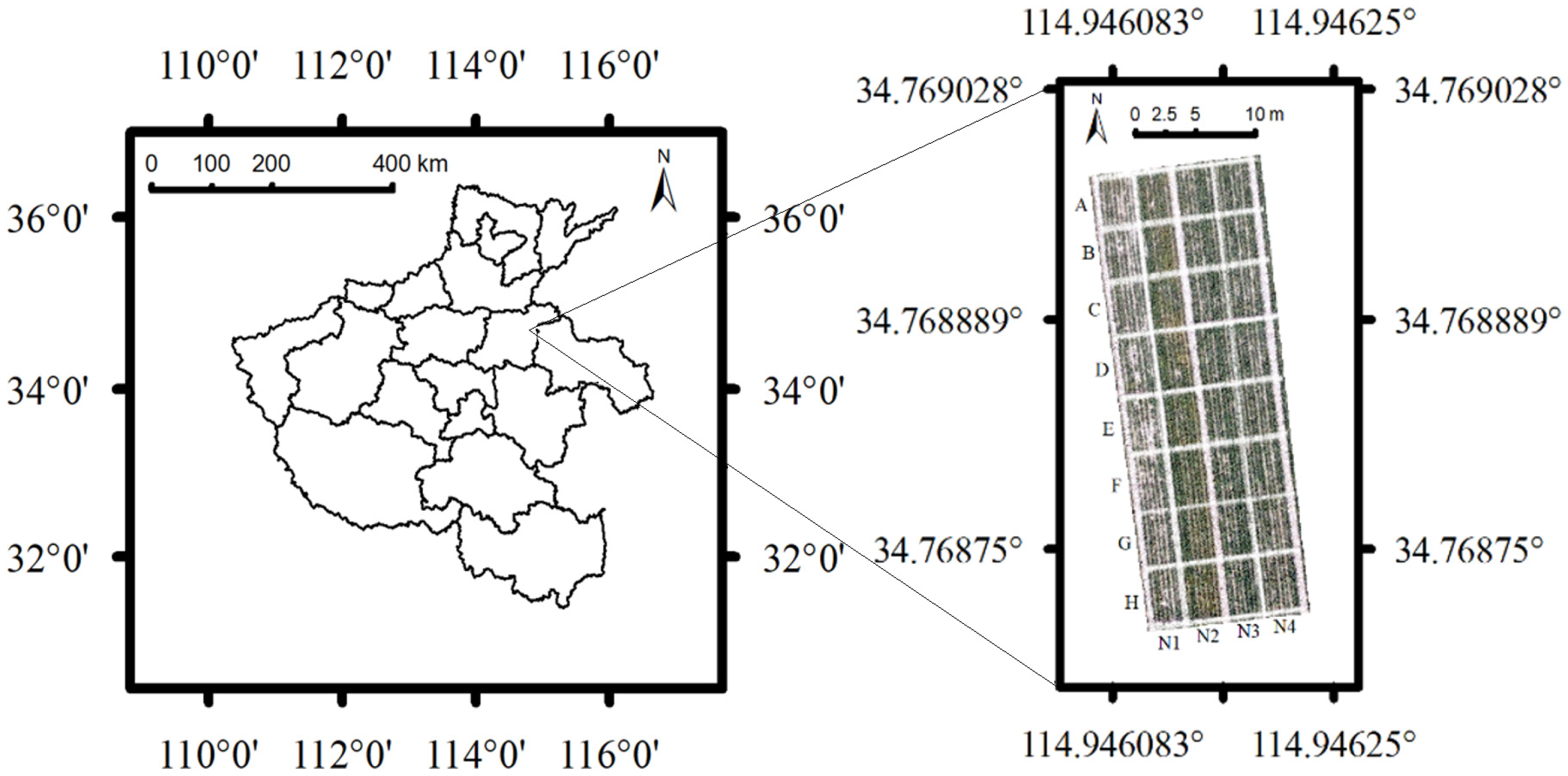
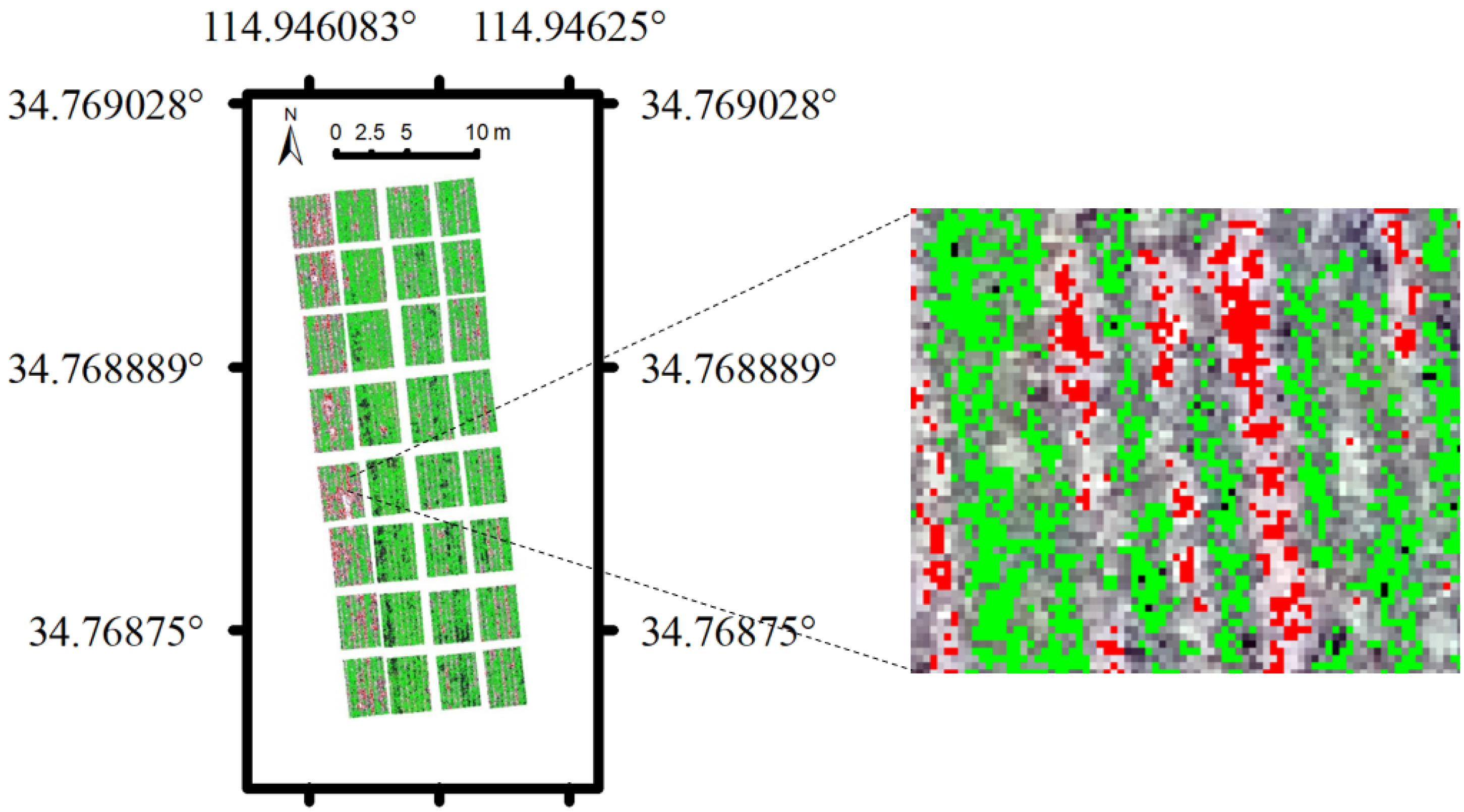
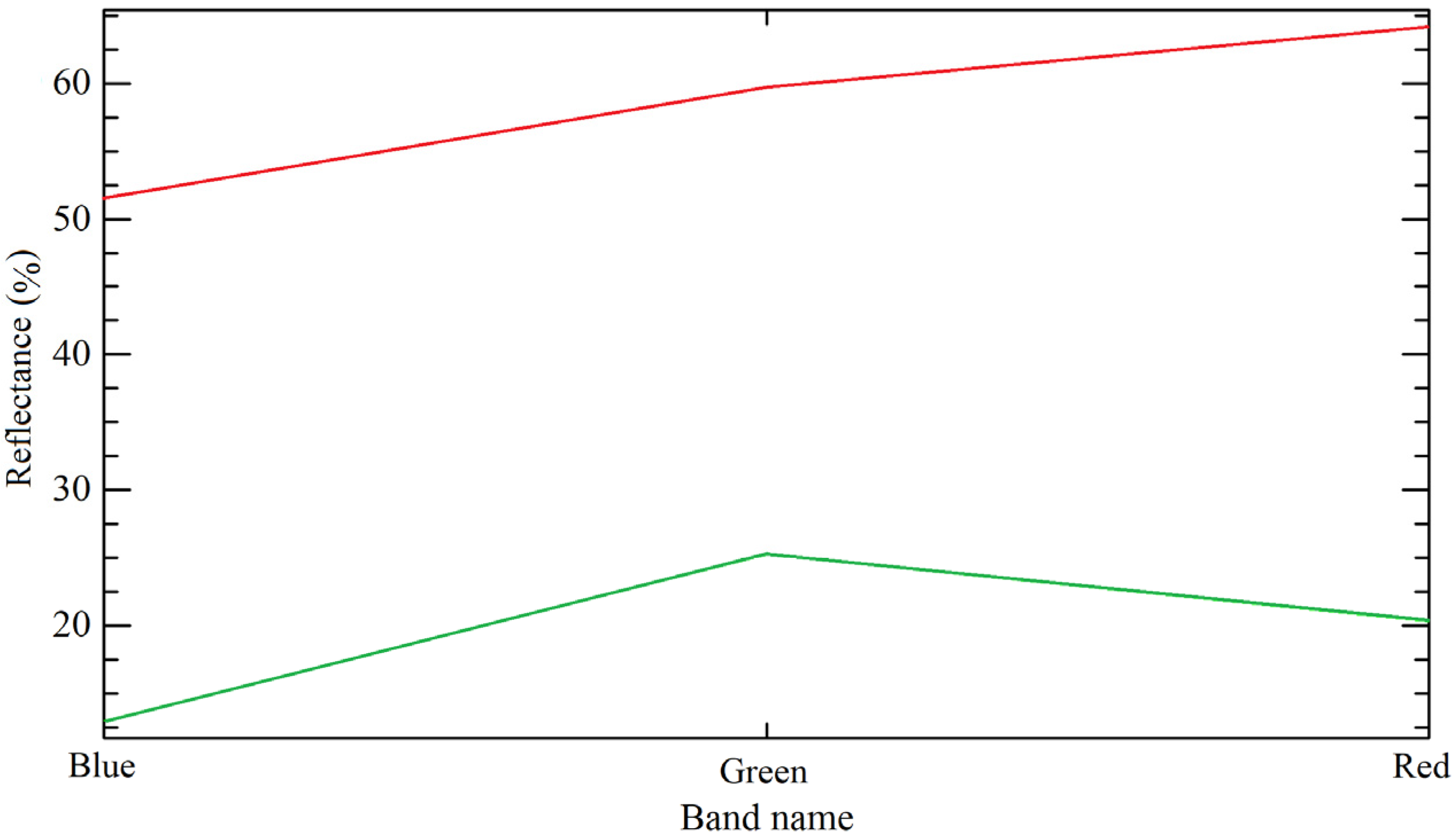
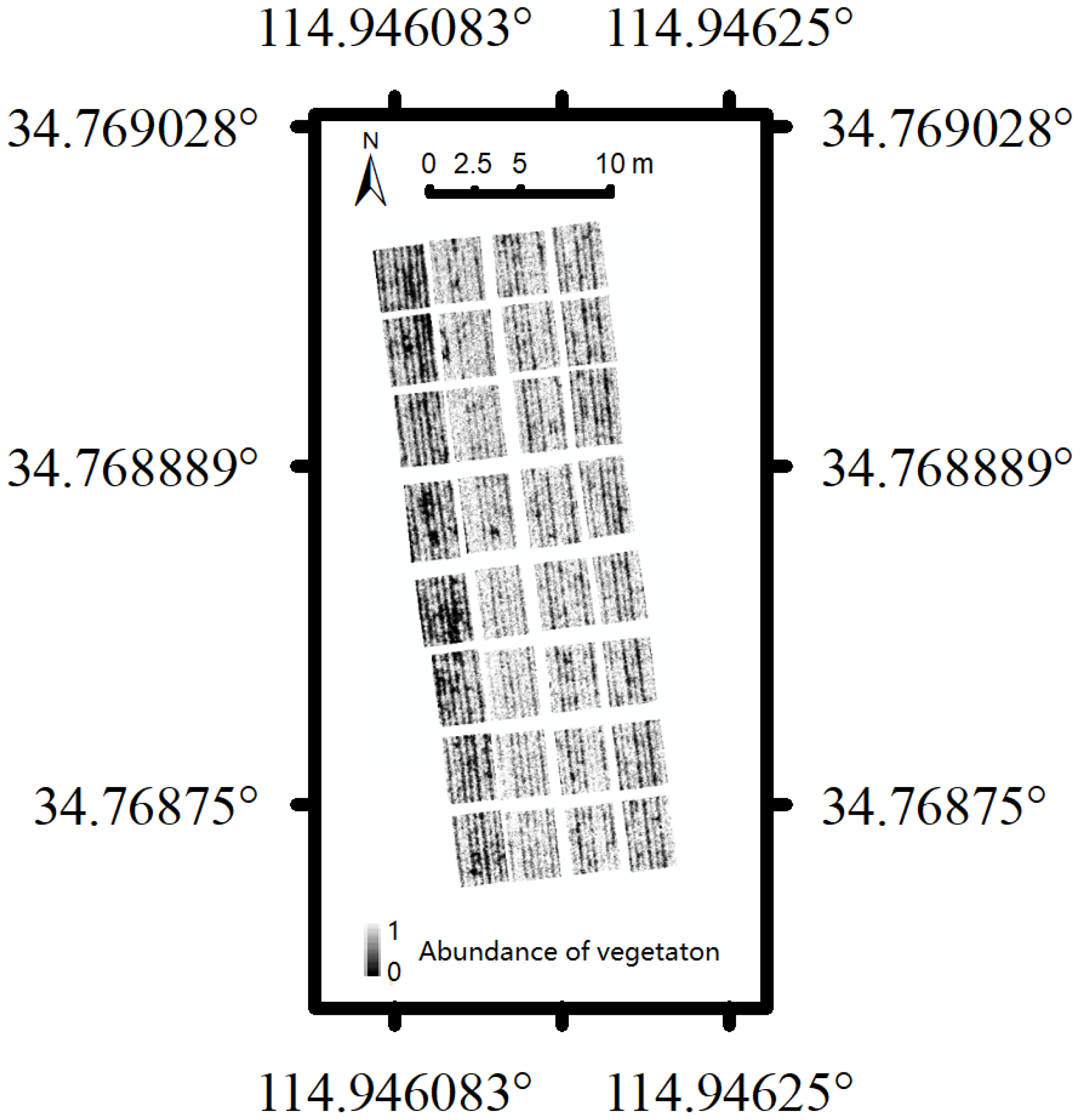
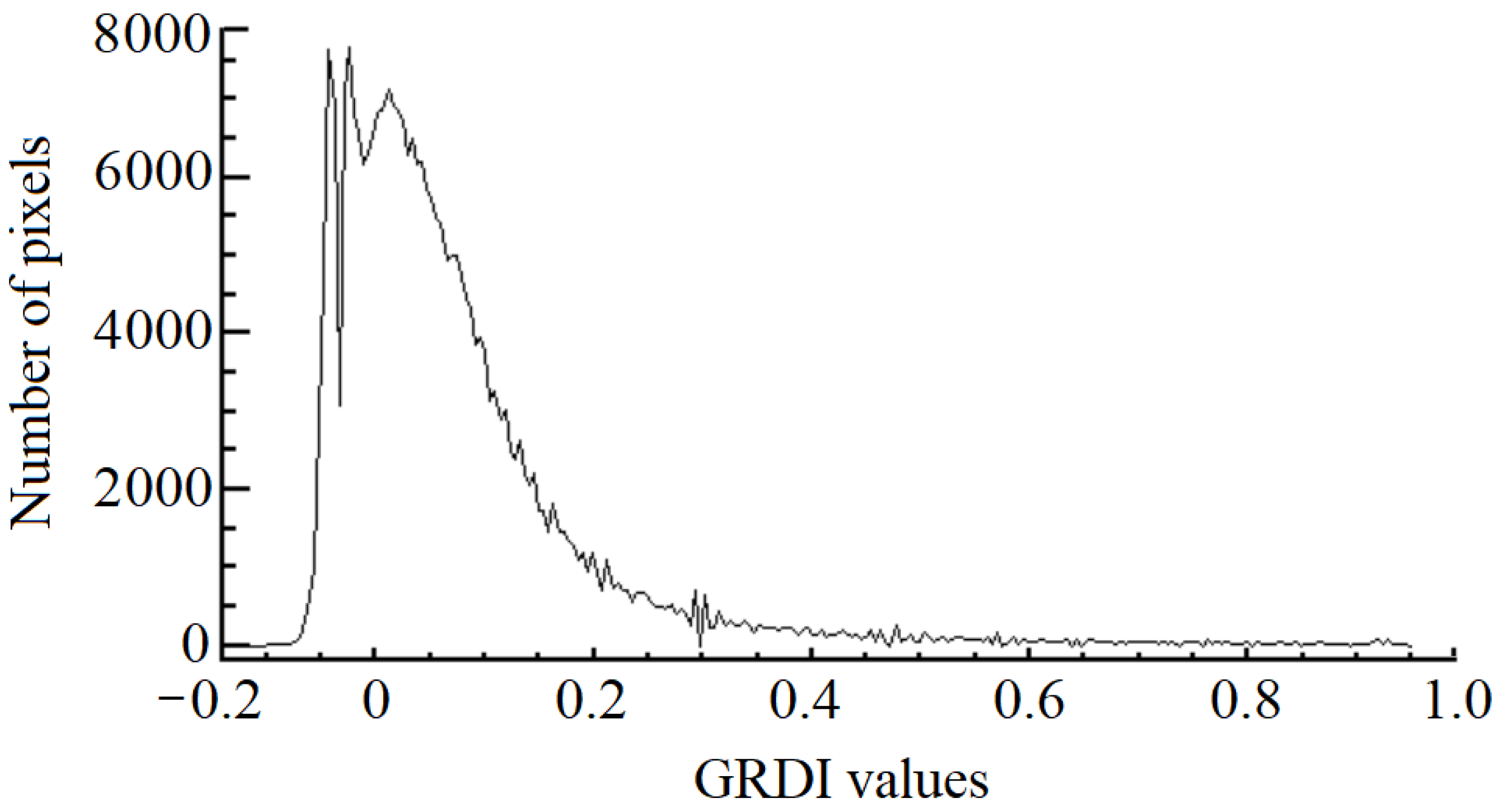
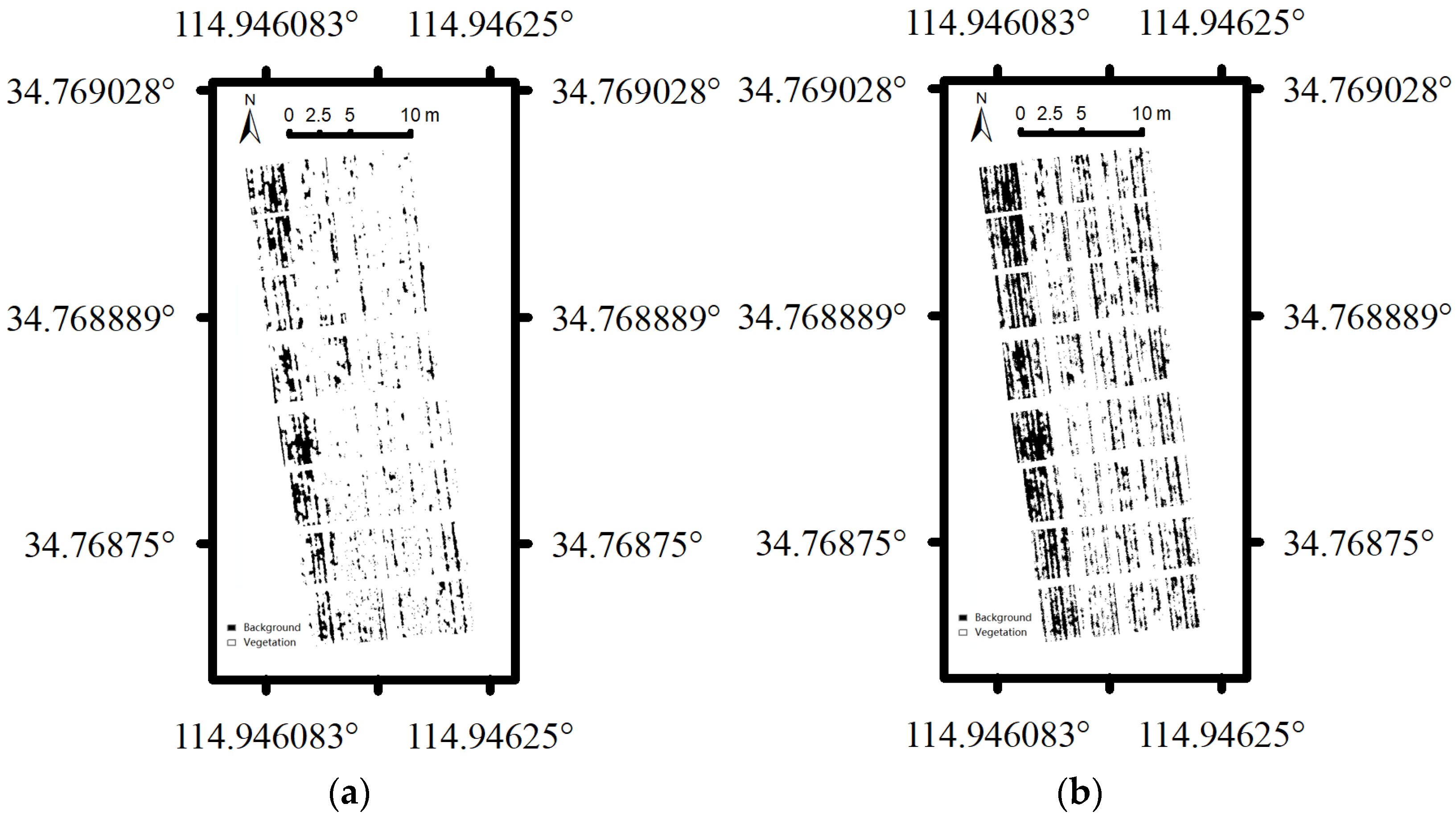
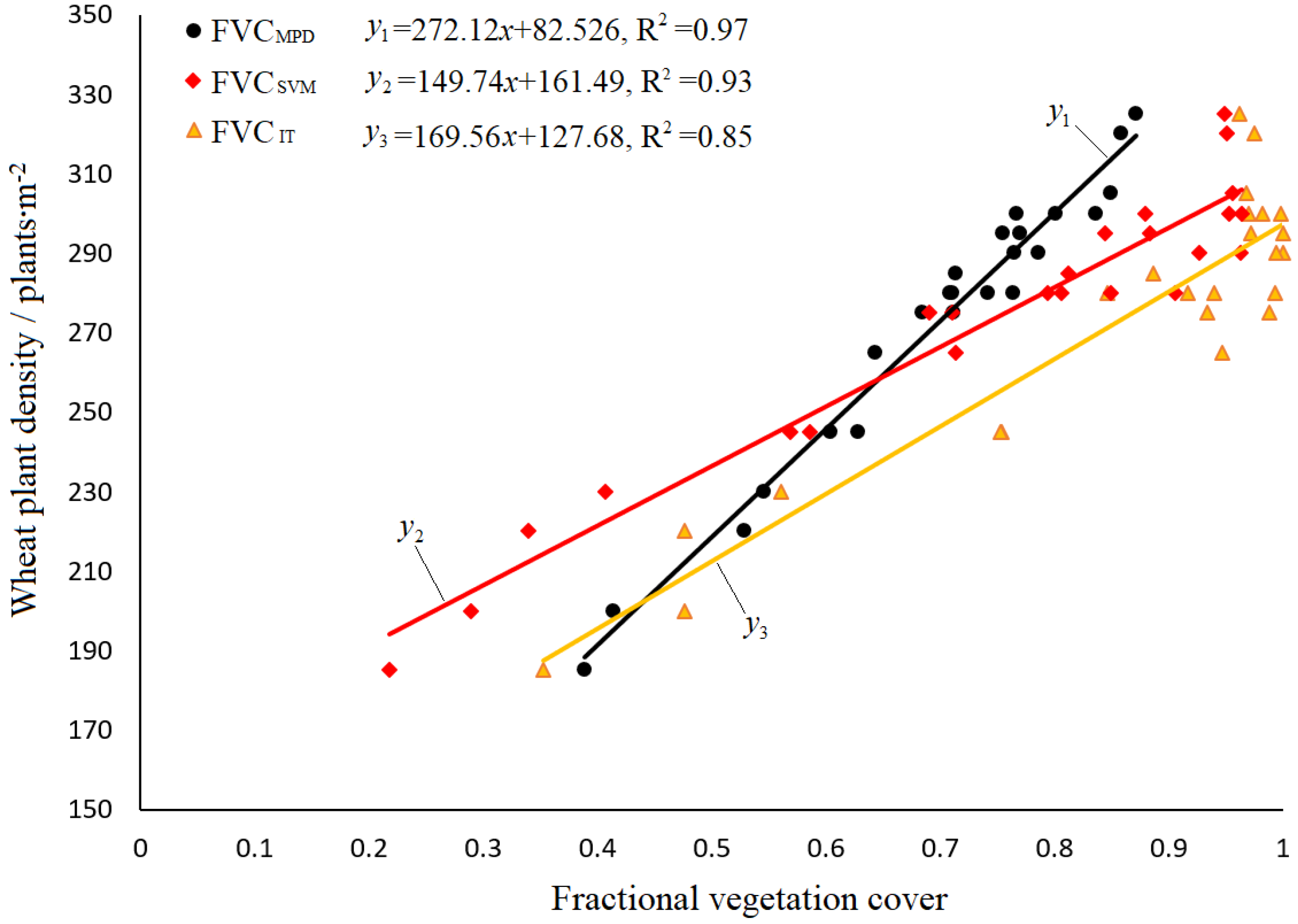
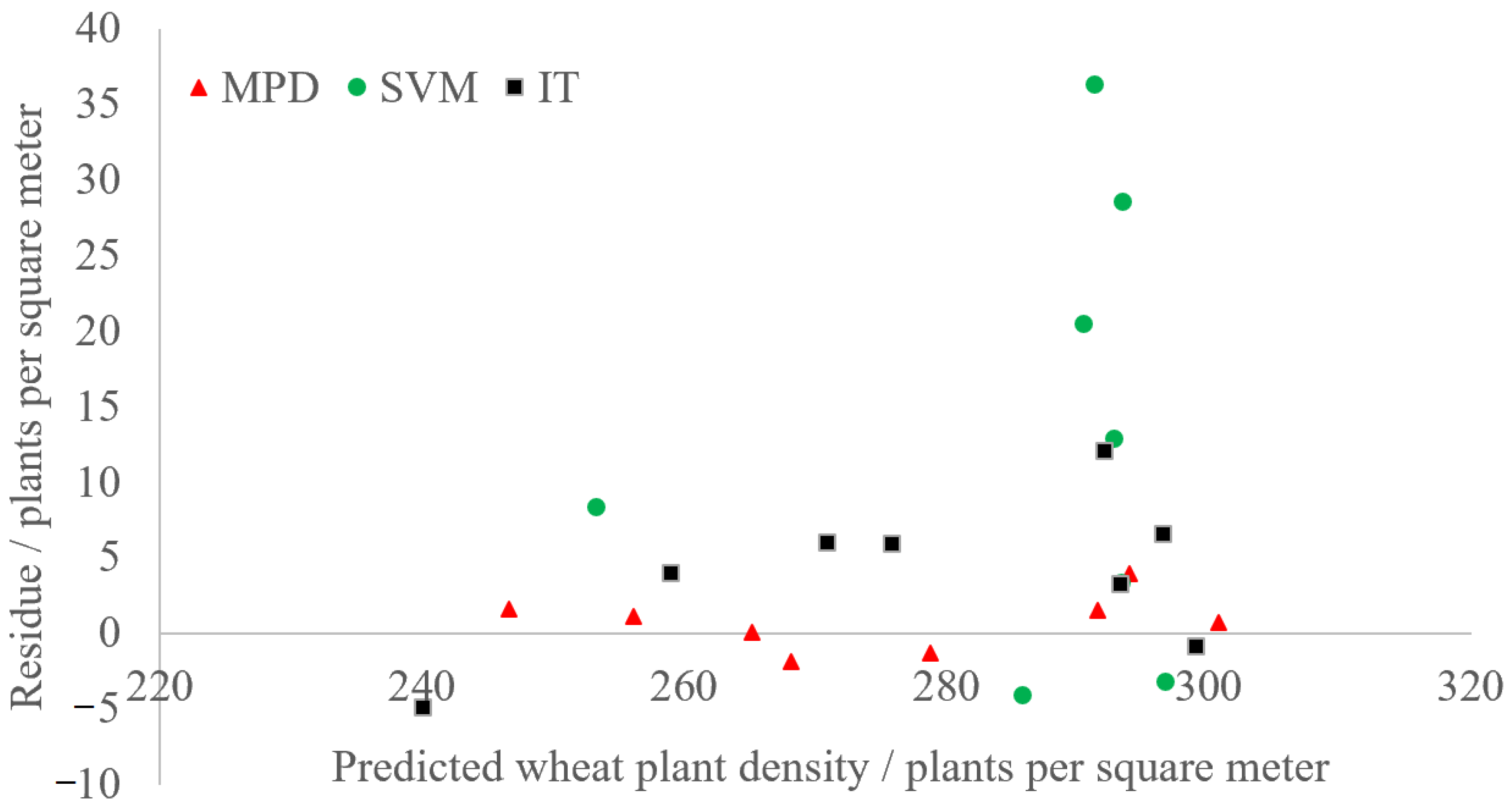

| Equipment | Items | Values |
|---|---|---|
| UAV | Overall size (mm) | 245 × 289 × 56 |
| Net weight (g) | 249 | |
| Altitude (m/s) | 80 | |
| Ground sampling distance (cm) | 2.5 | |
| Imaging Sensor | Angle of view (°) | 83 |
| Type of imager | CMOS | |
| Effective pixels | 2250 × 4000 | |
| Equivalent focal length (mm) | 24 | |
| Exposure time (s) | 1/1000 | |
| ISO sensitivity | 100 | |
| Spectral band | RGB |
| Nitrogen Treatment | Wheat Plant Density of Each Plot (Plants/m2) | |||||||
|---|---|---|---|---|---|---|---|---|
| A | B | C | D | E | F | G | H | |
| N1 | 230 | 200 | 255 | 245 | 185 | 245 | 220 | 245 |
| N2 | 285 | 280 | 280 | 290 | 295 | 290 | 280 | 300 |
| N3 | 265 | 295 | 300 | 305 | 300 | 290 | 320 | 325 |
| N4 | 280 | 300 | 265 | 275 | 290 | 270 | 275 | 280 |
| Nitrogen Treatment | Wheat Plants Number of Each Plot | |||||||
|---|---|---|---|---|---|---|---|---|
| A | B | C | D | E | F | G | H | |
| N1 | 46 | 40 | 51 | 49 | 37 | 49 | 44 | 49 |
| N2 | 57 | 56 | 56 | 58 | 59 | 58 | 56 | 60 |
| N3 | 53 | 59 | 60 | 61 | 60 | 58 | 64 | 65 |
| N4 | 56 | 60 | 53 | 55 | 58 | 54 | 55 | 56 |
| Endmember Category | Spectral Band | Average of Reflectance | Standard Deviation of Reflectance |
|---|---|---|---|
| Blue | 0.118 | 0.055 | |
| Vegetation | Green | 0.241 | 0.056 |
| Red | 0.191 | 0.065 | |
| Blue | 0.52 | 0.032 | |
| Soil | Green | 0.602 | 0.027 |
| Red | 0.645 | 0.029 |
| Plot | FVC | Plot | FVC | ||||
|---|---|---|---|---|---|---|---|
| FVCMPD | FVCIT | FVCSVM | FVCMPD | FVCIT | FVCSVM | ||
| N1A | 0.546 | 0.561 | 0.407 | N3A | 0.643 | 0.947 | 0.714 |
| N1B | 0.414 | 0.476 | 0.289 | N3B | 0.755 | 0.972 | 0.844 |
| N1C | 0.638 | 0.965 | 0.651 | N3C | 0.802 | 0.997 | 0.919 |
| N1D | 0.604 | 0.754 | 0.569 | N3D | 0.849 | 0.968 | 0.956 |
| N1E | 0.389 | 0.353 | 0.218 | N3E | 0.836 | 0.982 | 0.953 |
| N1F | 0.603 | 0.741 | 0.525 | N3F | 0.777 | 0.977 | 0.902 |
| N1G | 0.529 | 0.476 | 0.339 | N3G | 0.858 | 0.975 | 0.951 |
| N1H | 0.628 | 0.753 | 0.586 | N3H | 0.871 | 0.962 | 0.949 |
| N2A | 0.714 | 0.886 | 0.812 | N4A | 0.742 | 0.993 | 0.906 |
| N2B | 0.709 | 0.917 | 0.794 | N4B | 0.801 | 0.998 | 0.964 |
| N2C | 0.721 | 0.974 | 0.872 | N4C | 0.671 | 0.978 | 0.731 |
| N2D | 0.765 | 1 | 0.963 | N4D | 0.684 | 0.982 | 0.69 |
| N2E | 0.77 | 1 | 0.883 | N4E | 0.786 | 0.994 | 0.927 |
| N2F | 0.768 | 0.933 | 0.88 | N4F | 0.682 | 0.96 | 0.764 |
| N2G | 0.711 | 0.846 | 0.806 | N4G | 0.712 | 0.934 | 0.711 |
| N2H | 0.767 | 0.97 | 0.879 | N4H | 0.764 | 0.94 | 0.849 |
| Plot | Estimated Wheat Plant Density from FVC Values (Plants/m2) | Ground Truth of Test Data (Plants/m2) | ||
|---|---|---|---|---|
| FVCMPD | FVCIT | FVCSVM | ||
| N1C | 256.138 | 291.305 | 258.970 | 255 |
| N2C | 278.724 | 292.831 | 292.063 | 280 |
| N3C | 300.766 | 296.731 | 299.101 | 300 |
| N4C | 265.118 | 293.509 | 270.949 | 265 |
| N1F | 246.614 | 253.323 | 240.103 | 245 |
| N2F | 291.514 | 285.879 | 293.261 | 290 |
| N3F | 293.963 | 293.340 | 296.555 | 290 |
| N4F | 268.111 | 290.457 | 275.891 | 270 |
Disclaimer/Publisher’s Note: The statements, opinions and data contained in all publications are solely those of the individual author(s) and contributor(s) and not of MDPI and/or the editor(s). MDPI and/or the editor(s) disclaim responsibility for any injury to people or property resulting from any ideas, methods, instructions or products referred to in the content. |
© 2023 by the authors. Licensee MDPI, Basel, Switzerland. This article is an open access article distributed under the terms and conditions of the Creative Commons Attribution (CC BY) license (https://creativecommons.org/licenses/by/4.0/).
Share and Cite
Du, M.; Li, M.; Noguchi, N.; Ji, J.; Ye, M. Retrieval of Fractional Vegetation Cover from Remote Sensing Image of Unmanned Aerial Vehicle Based on Mixed Pixel Decomposition Method. Drones 2023, 7, 43. https://doi.org/10.3390/drones7010043
Du M, Li M, Noguchi N, Ji J, Ye M. Retrieval of Fractional Vegetation Cover from Remote Sensing Image of Unmanned Aerial Vehicle Based on Mixed Pixel Decomposition Method. Drones. 2023; 7(1):43. https://doi.org/10.3390/drones7010043
Chicago/Turabian StyleDu, Mengmeng, Minzan Li, Noboru Noguchi, Jiangtao Ji, and Mengchao (George) Ye. 2023. "Retrieval of Fractional Vegetation Cover from Remote Sensing Image of Unmanned Aerial Vehicle Based on Mixed Pixel Decomposition Method" Drones 7, no. 1: 43. https://doi.org/10.3390/drones7010043
APA StyleDu, M., Li, M., Noguchi, N., Ji, J., & Ye, M. (2023). Retrieval of Fractional Vegetation Cover from Remote Sensing Image of Unmanned Aerial Vehicle Based on Mixed Pixel Decomposition Method. Drones, 7(1), 43. https://doi.org/10.3390/drones7010043







